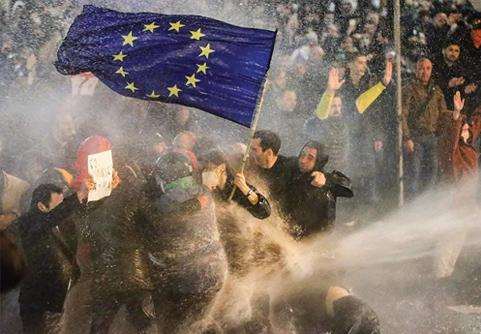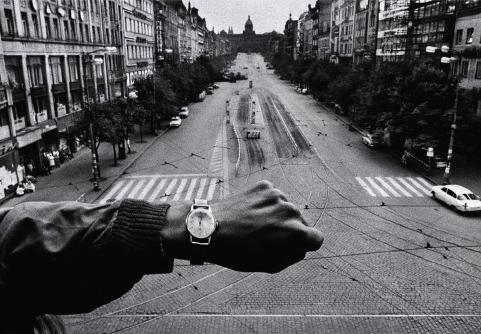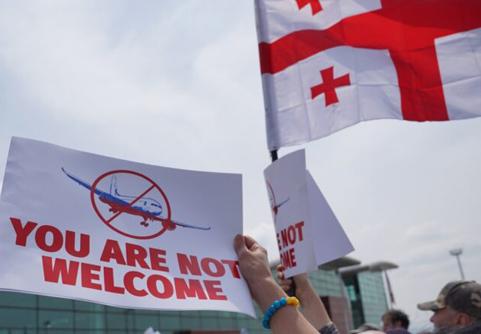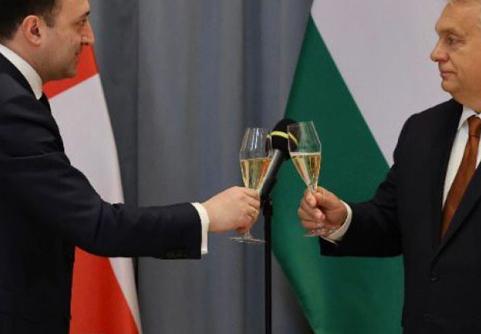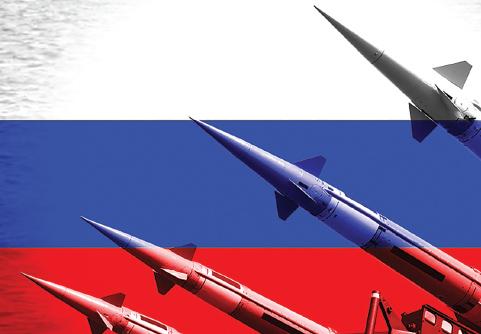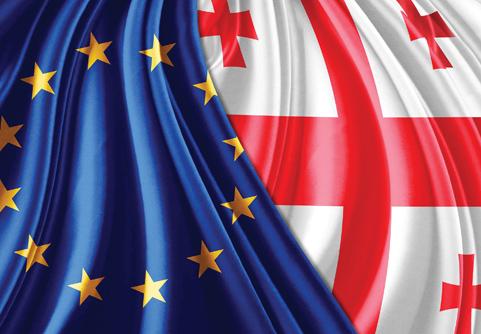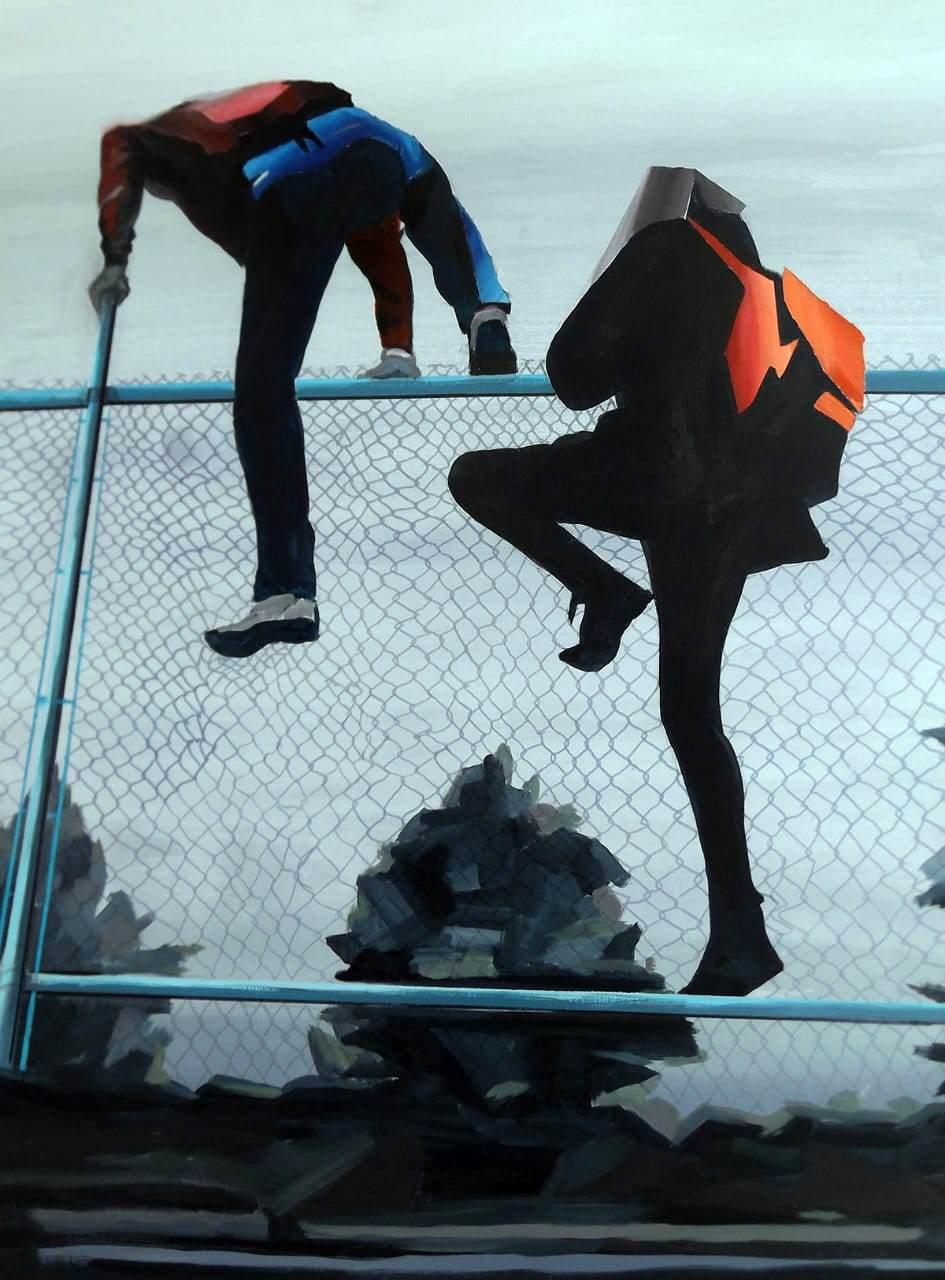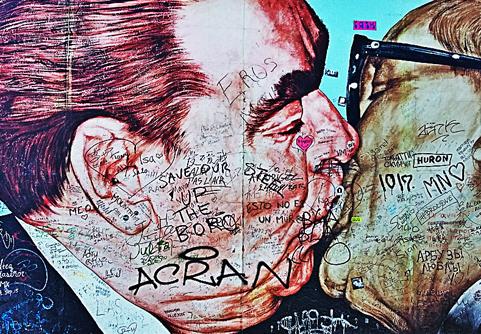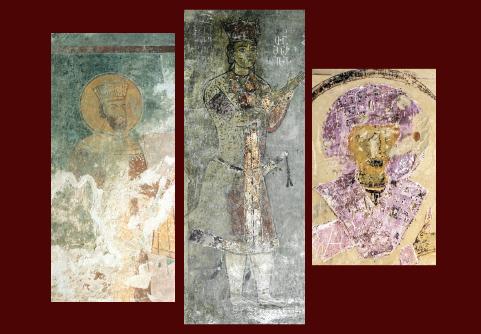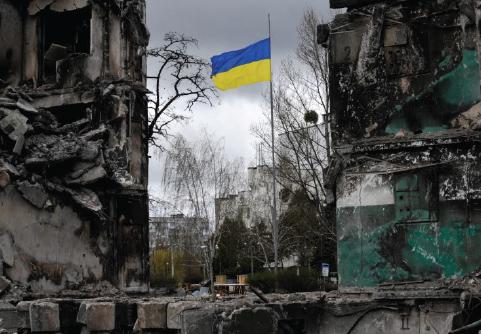
Author : Giga Jokhadze
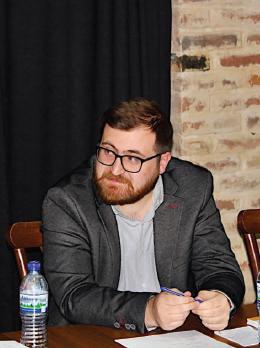
24 February marked one year since the unjustified and unprovoked intervention of the Russian Federation in Ukraine. In December 2021, Russian President Vladimir Putin sent the collective West a list of ultimatums in which he demanded written guarantees from NATO on the issue of no further enlargement. At the same time, Putin began mobilising a 200,000-strong military contingent near the Ukrainian border under the pretext of military exercises. On 21 February 2022, Putin took a major step towards escalating the conflict by recognising the self-proclaimed republics of Donetsk and Luhansk and proclaiming the Kremlin’s main goal to “restore” these republics within their administrative boundaries. With this move, it became clear that the Russian president was trying to find a casus belli that would justify a full-scale intervention in Ukraine.
On 24 February at dawn, Putin invaded Ukraine on the pretext of protecting Russian citizens. Most international relations experts believed that Putin would limit himself to the Donbass region, but to the surprise of many, the Kremlin launched hostilities virtually across the entire territory of Ukraine and even attacked Kyiv. The attack on Kyiv showed that Putin’s main goal was not to cut a land corridor connecting Crimea and to “return” Donbass to its administrative borders, but to annex the country completely and change the regime. According to the US and British intelligence, Kyiv was expected to fall within the following 96 hours. Western countries offered Zelenskyy political asylum, but the Ukrainian president refused to flee and led Ukraine’s fight for freedom and territorial integrity. The fighting of the first few days had a particularly significant impact on the course of the war. The effectiveness of the Ukrainian armed forces and territorial defence units, the high morale of the Ukrainians, and the logistical problems of the Russian army made a quick victory planned by the Kremlin in the early days of the war impossible.
The course of the war and the situation at the front – the Russian army launched combat operations in 4 main directions: 1. The Northern Front, where the goal was to capture the capital of the country, change the regime and quickly break the resistance of the Ukrainians; 2. The Northeastern Front, where Putin’s main goal was Kharkiv, the second largest city in Ukraine and the main industrial centre; 3. The Eastern Front, where the Kremlin’s goal was to “restore” the administrative borders of Donetsk and Lugansk; 4. The Southern Front, where the goal was to create a land corridor to the annexed Crimean peninsula and deprive Ukraine of access to the Black and Azov Seas. During the first phase of the war, the Kremlin scored successes on almost all fronts. On the Southern Front, the Russian army quickly captured the port city of Kherson and besieged the strategic city of Mariupol, blockading it for almost three months. The Kremlin made advances towards Kharkiv and Donbass, whilst the Kyiv front was the most unsuccessful. Putin soon realised that the Ukrainian capital was a well-defended stronghold and that taking it would pose enormous military and economic difficulties, so on 29 March 2022 he decided to withdraw Russian military units from the vicinity of the capital. Putin declared that in the second phase of the war the Kremlin would concentrate mainly on the Eastern and Southern Fronts. This was an indirect admission of defeat on the Northern Front. Since June, it has become evident that Ukraine has moved from defensive to offensive in many directions, thanks to the influx of advanced Western weaponry into Ukraine.
Particularly effective were the HIMARS multiple rocket launchers, with the help of which Ukraine reached the annexed Crimean Peninsula in August, where the Ukrainians destroyed a large Russian military warehouse.
By early September, the Ukrainians had regained the strategic initiative in the war. In the first days of September, Ukrainian territorial defence units launched a powerful counter-offensive in the direction of Kharkiv, liberating 8,500 square kilometres of territory. The Ukrainian counter-offensive eliminated the Northeastern Front, depriving Russia of the northern corridor linking it to Donbass. There have been no significant territorial changes on either front since the end of October. The Russian Federation’s only success was the capture of the town of Soledar on the Eastern Front. Russian artillery has been shelling the town of Bakhmut in Donbass for months but had yet failed to capture it.
One year after the start of the war in Ukraine, we can safely say that the Russian Federation has not achieved its strategic objectives in any direction. After Kherson and Mariupol, the Russian Federation has not captured a single strategically important object. The failure of the Russian army is also evidenced by the fact that 2 of the 4 main fronts of the war (Kyiv, Kharkiv) have been completely demolished, and on the other two fronts the Russians have made virtually no progress.
International reaction - After Russia’s full-scale intervention in Ukraine, the civilised world agreed that the Kremlin’s Ukraine adventure would cost it dearly. In the early days of the war, the West imposed tough economic sanctions on the Russian Federation. The most significant of these was the exclusion of the majority of major Russian banks from the global financial system, SWIFT. The West also restricted Russia’s access to its foreign currency reserves, which totalled $450 billion. Putin’s inner circle, Russian MPs, and oligarchs, had most of their financial assets in the West frozen. A large number of international companies have suspended operations in Russia. Most countries have halved or stopped trade with Russia, especially in the military, oil, and high-tech sectors. And Germany suspended the Nord Stream 2 project.
The answer to the question of how effective Western sanctions is against Russia depends on how we define the West’s goal. If the West’s goal was the complete collapse of the Russian Federation and the change of Putin’s regime, then the sanctions are not effective enough. This goal can only be achieved by imposing a complete embargo on energy resources, since the Russian economy is critically dependent on revenues from energy exports. Such a scenario is difficult to imagine. But if the West’s goal was to gradually weaken Putin’s regime, it has certainly achieved that goal. Most of the sanctions imposed are designed to gradually weaken Putin’s regime over time. Achieving European energy independence is particularly important for weakening the Kremlin. Before the war in Ukraine, about 40 percent of the continent’s gas supply came from the Russian Federation. Russian propaganda talked pointedly about the approaching winter and the threat of Europe “freezing”, even though most European countries have either banned gas purchases from Russia altogether or significantly reduced their dependence on it. Dependence on Russia fell from 40 percent to 7.5 percent by the end of October. The EU began to look for new partners and by early autumn had fully replenished its winter reserves. The weakening of the EU’s energy dependence on Russia finally put an end to speculation that Europe was in danger of freezing and deprived the Kremlin of an important political leverage.
In parallel with the weakening of Russia, the West has started to work actively on strengthening Ukraine’s military capabilities. Over the past year, the Western world has provided Ukraine with military, economic, and humanitarian aid worth about 150 billion dollars. The most significant contribution to the assistance to Ukraine has been made by the USA, which has provided about 70 billion dollars in aid to Ukraine since the beginning of the war. Most of this aid ($44 billion) went directly to military assistance. The European Union helped Ukraine with almost 30 billion dollars, with the United Kingdom, Canada, Poland and others providing 3 billion dollars each. Winning the war is impossible without the transfer of modern weapons to Ukraine, and the West has been particularly active in this direction since the beginning of 2023.
In 2023, the United States alone has allocated almost 4 billion dollars to Ukraine, which will be used to purchase several dozen tanks, armoured personnel carriers, anti-tank defence systems and tens of thousands of shells. In January, another meeting of the Ukrainian support group was held at the Ramstein base, where it was decided to transfer more than 500 modern tanks to Ukraine during 2023. Overall, over the past year, the West has taken significant steps to defeat Putin’s regime in Ukraine. As such, it is likely that the quality and quantity of aid will increase further over time to ensure Ukraine’s victory.
Future scenarios - According to Western intelligence, the Russian Federation is going to organise a new offensive campaign in Ukraine from spring, for which it is preparing new flows of reservists and massive quantities of new weapons. In response, the West is building up Ukraine’s self-defence capabilities. There is a consensus in the West that the war should end with a complete and unconditional victory for Ukraine. Against this background, it is impossible to develop a scenario in which Russia manages to annex Ukraine and changes the regime. It will be difficult for Russia to retain the already occupied territories. It is more likely that Putin’s regime will try to prepare a new offensive and seize more territory to put itself in a strong position for negotiations. Putin is trying to get Ukraine to agree to negotiations on his terms. The Russian President’s goal is the international legitimacy of the territories he has annexed (Crimea, Donetsk, Luhansk, Kherson, and Zaporizhzhia), Ukraine’s military neutrality and the rejection of Euro-Atlantic structures.
The goal of the Ukrainian government, on the other hand, is the complete liberation of the territories of Ukraine, including the Crimean Peninsula. Given the complete incompatibility of the goals of the actors, it is practically impossible to hold negotiations between Russia and Ukraine in the near future, which is confirmed by the statements of Ukrainian officials. In international politics it is difficult to predict anything in advance, but one thing is clear, that one year after the start of the war, Ukraine firmly stands on its feet. The Ukrainian people are ready to fight for final victory until the last Russian soldier leaves the country. We wish them a swift and decisive victory in this noble cause!
